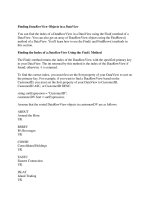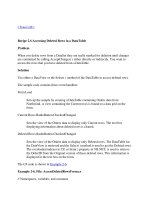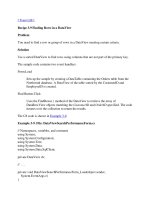Tài liệu Accessing Deleted Rows in a DataTable pptx
Bạn đang xem bản rút gọn của tài liệu. Xem và tải ngay bản đầy đủ của tài liệu tại đây (42.41 KB, 10 trang )
[ Team LiB ]
Recipe 2.6 Accessing Deleted Rows in a DataTable
Problem
When you delete rows from a DataSet they are really marked for deletion until changes
are committed by calling AcceptChanges( ) either directly or indirectly. You want to
access the rows that you have deleted from a DataTable.
Solution
Use either a DataView or the Select( ) method of the DataTable to access deleted rows.
The sample code contains three event handlers:
Form.Load
Sets up the sample by creating a DataTable containing Orders data from
Northwind. A view containing the Current rows is bound to a data grid on the
form.
Current Rows RadioButton.CheckedChanged
Sets the view of the Orders data to display only Current rows. The text box
displaying information about deleted rows is cleared.
Deleted Rows RadioButton.CheckedChanged
Sets the view of the Orders data to display only Deleted rows. The DataTable for
the DataView is retrieved and the Select( ) method is used to get the Deleted rows.
The overloaded indexer in C#, or Item( ) property in VB.NET, is used to retrieve
the OrderID from the Original version of these deleted rows. This information is
displayed in the text box on the form.
The C# code is shown in Example 2-6
.
Example 2-6. File: AccessDeletedRowsForm.cs
// Namespaces, variables, and constants
using System;
using System.Configuration;
using System.Text;
using System.Data;
using System.Data.SqlClient;
private DataView dv;
// . . .
private void AccessDataSetDeletedRowsForm_Load(object sender,
System.EventArgs e)
{
// Fill the Orders table.
SqlDataAdapter da = new SqlDataAdapter("SELECT * FROM Orders",
ConfigurationSettings.AppSettings["Sql_ConnectString"]);
DataTable dt = new DataTable("Orders");
da.Fill(dt);
// Define a view of just the Current rows.
dv = new DataView(dt, null, null, DataViewRowState.CurrentRows);
dataGrid.DataSource = dv;
currentRadioButton.Checked = true;
}
private void currentRadioButton_CheckedChanged(object sender,
System.EventArgs e)
{
// Filter to include only current rows.
dv.RowStateFilter = DataViewRowState.CurrentRows;
dataGrid.ReadOnly = false;
deletedTextBox.Clear( );
}
private void deletedRadioButton_CheckedChanged(object sender,
System.EventArgs e)
{
// Filter the view to include only deleted rows.
dv.RowStateFilter = DataViewRowState.Deleted;
dataGrid.ReadOnly = true;
// Get the DataTable from the DataView.
DataTable dt = dv.Table;
// Filter using the DataTable RowState.
DataRow[] delRows = dt.Select(null, null, DataViewRowState.Deleted);
StringBuilder sb = new StringBuilder("Deleted Records:" +
Environment.NewLine);
// Iterate over the collection of deleted rows.
foreach(DataRow row in delRows)
sb.Append("Order ID: " + row["OrderID",
DataRowVersion.Original] + Environment.NewLine);
deletedTextBox.Text = sb.ToString( );
}
Discussion
ADO.NET manages the state of the rows while they are being modified. Rows are
assigned a state from the DataRowState enumeration described in Table 2-4
.
Table 2-4. DataRowState enumeration
Value Description
Added
The row has been added to the collection of rows in the table but
AcceptChanges( ) has not been called.
Deleted
The row has been deleted from the collection of rows in the table but
AcceptChanges( ) has not been called.
Detached The row does not belong to the collection of rows in a DataTable.
Modified
The data in the row has been changed but AcceptChanges( ) has not been
called.
Unchanged
The data in the row has not been changed since it was loaded or since
AcceptChanges( ) was last called.
When AcceptChanges( ) is called on the DataSet, DataTable, or DataRow, either
explicitly or implicitly by calling the Update( ) method of the DataAdapter, the following
occurs:
•
All rows with a row state of Deleted are removed.
•
All other rows are assigned a row state of Unchanged and the Original row version
values are overwritten with the Current version values.
When RejectChanges( ) is called on the DataSet, DataTable, or DataRow, the following
occurs:
•
All rows with a row state of Added are removed.
•
All other rows are assigned a row state of Unchanged and the Current row version
values are overwritten with the Original row version values.
Each DataRow has a RowState property that returns the current state of the row.
ADO.NET maintains several versions of the data in each row while it is being modified
to allow the disconnected to be later reconciled with the data source. Table 2-5
describes
the DataRowVersion enumeration values.
Table 2-5. DataRowVersion enumeration
Value Description
Current Current value. This version does not exist for rows with a state of Deleted.
Default
Default value as determined by the DataRowState:
•
The Current version for rows with Added, Modified, or Unchanged
state
•
The Original version for rows with Deleted state
•
The Proposed value for rows with Detached state
Original Original value. This version does not exist for rows with a state of Added.
Proposed
Proposed value. This value exists during a row edit operation started either
implicitly or explicitly with the BeginEdit( ) method and for Detached rows.
The HasVersion( ) method of the DataRow object checks whether a particular row
version exists.
The DataViewRowState enumeration is used to retrieve a particular version of data or to
determine whether a version exists. It is used for this purpose by both the Select( )
method of the DataTable and by the RowStateFilter property of the DataView. You can
retrieve more than one version by using a Boolean OR of DataViewRowState values.
Table 2-6
describes the DataViewRowState enumeration values.
Table 2-6. DataViewRowState enumeration
Value Description
Added The Current version of all Added rows.
CurrentRows
The Current version of all Unchanged, Added, and Modified rows.
This is the default value.
Deleted The Original version of all Deleted rows.
ModifiedCurrent The Current version of all Modified rows.
ModifiedOriginal The Original version of all Modified rows.
None No rows.
OriginalRows The Original version of Unchanged, Modified, and Deleted rows.
Unchanged The Current version of all Unchanged rows.
The Current version of each row is retrieved by default when accessing rows in a
DataTable or in a DataView. The solution demonstrates an approach for getting Deleted
rows from both a DataTable and a DataView. Deleted rows include only those marked
for deletion using the Delete( ) method of the DataRow or the DataView, not the
Remove( ) or RemoveAt( ) method of the DataRowCollection, which instead
immediately removes the specified DataRow from the collection.
The solution demonstrates two techniques for retrieving the deleted rows:
To get the Deleted rows from the DataTable, use an overload of the Select( ) method of
the DataTable to return an array of deleted DataRow objects. The overload accepts an
argument having a DataViewRowState enumeration value. To retrieve deleted rows, pass
a value of Deleted as the argument.
To get the Deleted rows from the DataView, set the RowStateFilter property of the
DataView to Deleted. Deleted rows are also visible, along with other rows, when you set
the RowStateFilter property to ModifiedOriginal and OriginalRows.
[ Team LiB ]
[ Team LiB ]
Recipe 2.6 Accessing Deleted Rows in a DataTable









